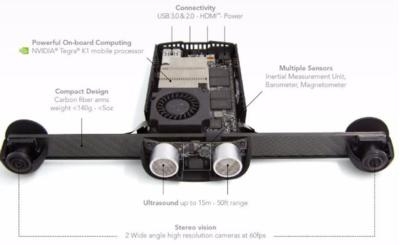Thu, Sep 08, 2016
Open Source Sense-And-Avoid Development Technology For Drone Kits
Parrot has rolled out an open development kit for the design of advanced applications for autonomous navigation, obstacle avoidance, indoor navigation and 3D mapping for drones and other robotic platforms in environments with multiple barriers and where GPS signals are not available.

Parrot S.L.A.M.dunk integrates advanced software applications based on a Simultaneous Localization and Mapping algorithm: S.L.A.M. S.L.A.M. technology enables the drone to understand and map its surroundings in 3D and to localize itself in environments with multiple barriers and where GPS signals are not available. With an embedded NVIDIA Tegra K1 processor, Parrot S.L.A.M.dunk allows implementation of the latest algorithms of computer vision and autonomous navigation that are optimized for NVIDIA® GPU. In addition, the Parrot S.L.A.M.dunk is optimized to minimally impact the battery life of the drone.
Parrot S.L.A.M.dunk integrates several sensors:
- A fish-eye stereo camera with a 1500x1500 resolution at 60fps
- An Inertial Measurement Unit (IMU)
- An ultrasound sensor
- A magnetometer
- A barometer

Parrot developed S.L.A.M.dunk to be as easy and user-friendly as possible for developers, researchers, integrators and academics. Sensors and algorithms are fully integrated in order to speed the design of advanced applications for drones and robotic platforms. All Ubuntu functionalities and benefits from ROS (Robot Operating System) framework are embedded in the Parrot S.L.A.M.dunk making it user-friendly. The HDMI port makes it possible to develop directly on the product.
Parrot S.L.A.M.dunk can be used for:
- Prototyping of drones and robotic solutions
- autonomous navigation of drones and robots
- 3D mapping
- Stereo camera and a sensor array (IMU, barometer, magnetometer, ultrasound)
Weighing less than 4.9oz, Parrot S.L.A.M.dunk fits on various types of Linux-based drones and robotic platforms including quadcopters and fixed-wings, rolling robots and articulated arms, with the help of mount kits. Once placed, Parrot S.L.A.M.dunk should be linked to the battery of its host-drone by a 3.5mm jack cable and a USB cable in order to send and receive information and commands to and from the drone. Developed by robotic researchers for robotic researchers, Parrot S.L.A.M.dunk is a ready-to-use module that will accelerate the development of tomorrow’s application for drones and robotic platforms.
(Images provided with Parrot news release)
More News
Newest USAF Drone Begins Process in Earnest The YFQ-42A Collaborative Combat Aircraft has begun its flight testing in coordination with the U.S. Air Force, taking a vital step towa>[...]
“What a great moment for the U.S. Air Force and for GA-ASI. It’s been our collaboration that enabled us to build and fly the YFQ-42A in just over a year. It’s an >[...]
Airline Pilots Jettisoned 15,000 Pounds of Fuel Over Populated Areas Five years after one of its Boeing 777s dumped 15,000 pounds of jet fuel onto neighborhoods, Delta Air Lines ha>[...]
GAO Report Says that Only 69 Aviation Meteorologists Work Alongside ATC A federal watchdog says the FAA is running the nation’s air traffic system with fewer weather experts >[...]
Also: 500-Aircraft Deal With China, Florida ANG's F-35, FAA Denies Petition, UC Central Arkansas Aviation Academy The Reno Air Racing Association (RARA) is offering its apologies t>[...]
 YFQ-42A Collaborative Combat Aircraft Starts Flight Testing
YFQ-42A Collaborative Combat Aircraft Starts Flight Testing Aero-News: Quote of the Day (09.02.25)
Aero-News: Quote of the Day (09.02.25) Delta Settles Fuel Dump Lawsuit in a $78M Handshake
Delta Settles Fuel Dump Lawsuit in a $78M Handshake Watchdog Warns of Another Understaffed FAA Program: Meteorology
Watchdog Warns of Another Understaffed FAA Program: Meteorology Airborne 08.27.25: Air Race Tkt Discounts, Europe AvGas, Deportation Flights?
Airborne 08.27.25: Air Race Tkt Discounts, Europe AvGas, Deportation Flights?




